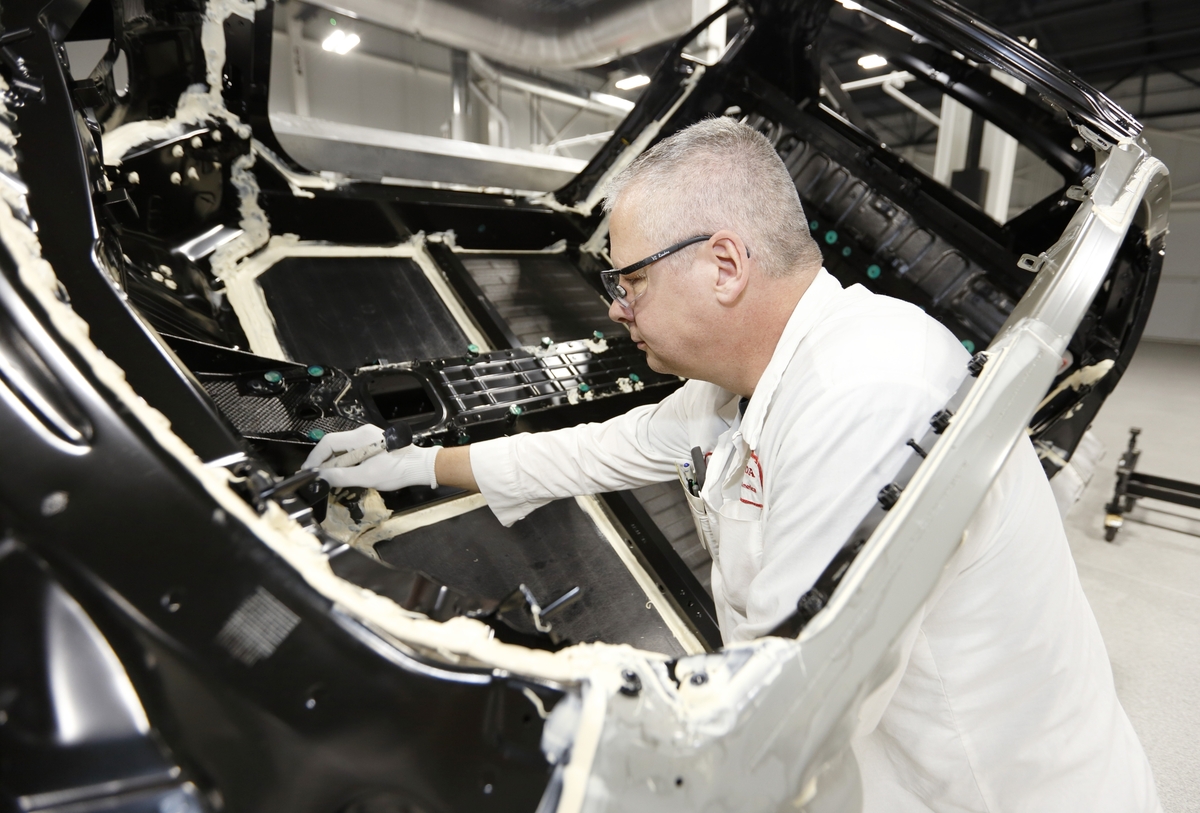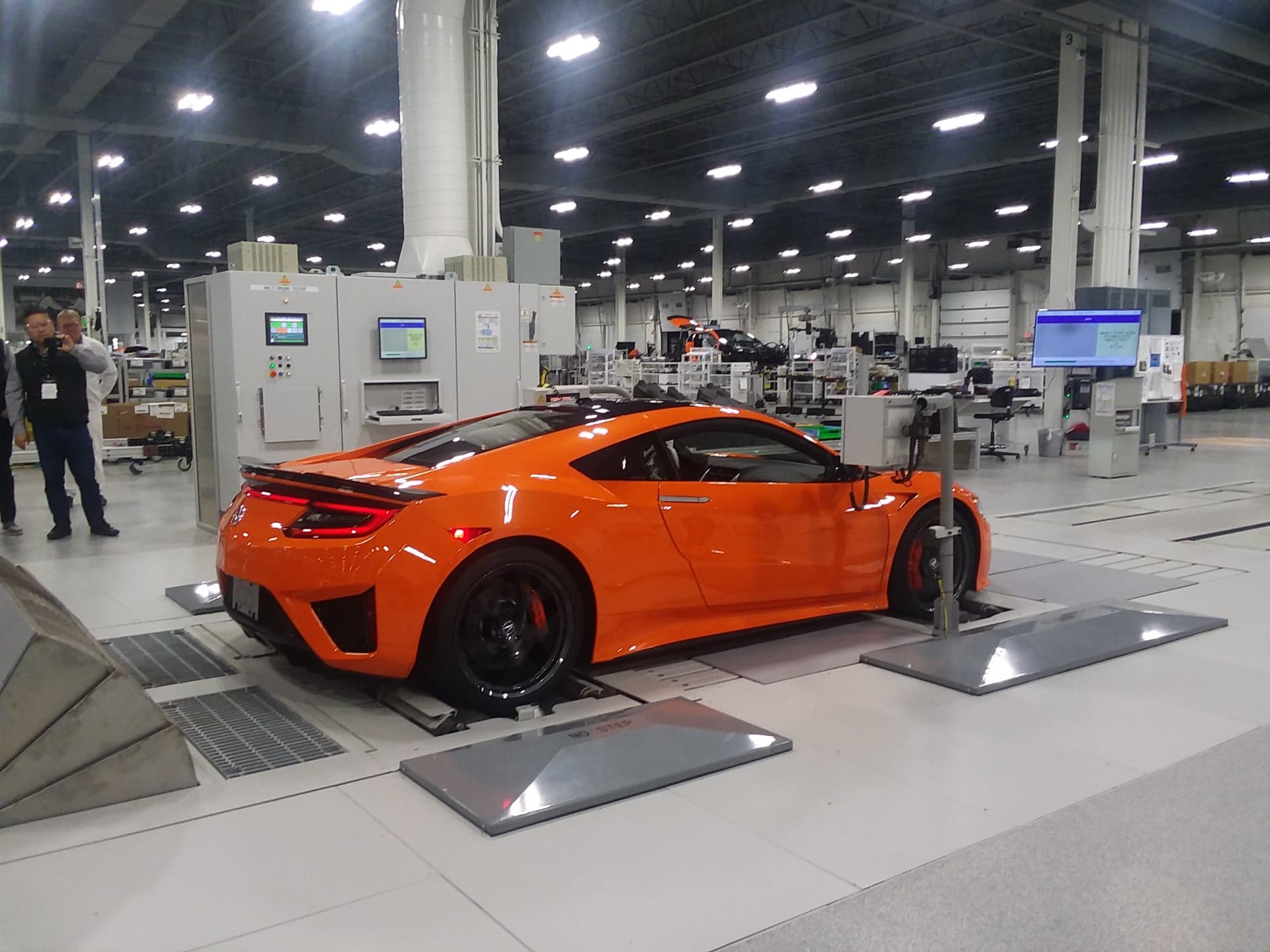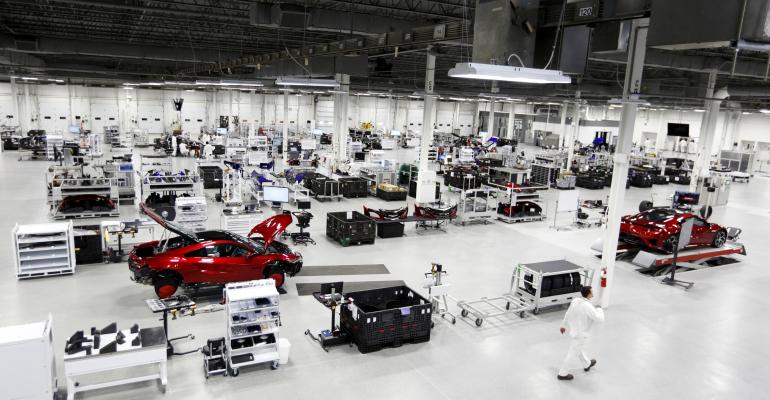MARYSVILLE, OH – Inside a former Honda logistics building near the automaker’s longtime Accord midsize-car plant here, every NSX supercar sold worldwide is assembled.
But unlike that other Marysville plant, in this building roughly the size of a couple Costcos, there is no moving assembly line and not much noise to speak of, or over for that matter.
“You'll notice in assembly the cars are pushed,” Assembly Manager Jeff Britton says during a recent media tour of Acura’s Performance Manufacturing Center. “We are on wheels. There’s no chains here. Everything is completely manual.”
Not quite everything about the construction of the NSX is manual, but much of it is. Acura prides itself on the fact the car is mostly hand-built, for all global markets, here in central Ohio. Previous generations of the NSX, which is sold outside the U.S. and China as the Honda NSX, were assembled in the automaker’s home country of Japan.
As is typical of modern supercar manufacturing, there’s extra human involvement in the production of this low-volume specialty vehicle.
Acura can assemble up to 10 NSXs per day in this facility, although Wards Intelligence data shows 340 NSXs were built here through September, down from 739 in like-2017 and equal to 2.3 per day given roughly 150 working days this year (the plant operates on a 4-day, 10-hour week).
Last year Acura assembled NSXs sans orders to build inventory, but this year it is assembling each model to order.
“We get the dealer order, we produce by the color and we do have factory-installed features here,” Britton says. “Our customer can pick out what color seats (they desire), (upgrade to) power seats, (choose various) brake systems, this and that.”
For instance, the NSX’s standard cast-iron brake rotors for ’19 now can be had with red calipers, a $700 upcharge vs. the standard black calipers. Those selecting the optional carbon ceramic metallic brakes now can opt for orange calipers ($10,600), which match the car’s new Thermal Orange exterior paint offering. Carbon-ceramic rotors also can be had with silver ($10,600), black ($9,900) or red calipers ($10,600).
Other ways to customize the car include the addition of carbon-fiber exterior trim pieces ($9,000), a carbon-fiber rear spoiler ($3,000) and carbon-fiber interior trim package ($2,500).
While there is relatively little human interaction with the car during the welding, coating and painting processes compared with assembly and inspection, we get to view all during our visit.
In the weld area, the car’s spaceframe is held on a rotisserie-type fixture with 360-degree movement and 100% MIG-welded by eight robots applying 860-plus welds.
Fully automated MIG welding provides “high-quality, repeatability, and fast welding which allows for higher joint strength and higher performance of the vehicle,” says Chuck Henkel, weld manager at PMC.
The rotation of the rotisserie fixture, which Honda claims is unique within the industry, allows for each weld to be performed at the perfect angle. (Pictured below, a worker applies sealant to the body after welding and while it is on the rotisserie).

The NSX is mostly aluminum but also has some steel (A-pillars, roof rails) and carbon-fiber (optional roof) elements. Because of the need to join disparate materials and create a watertight, strong but flexible body, Acura also uses some advanced joining techniques, including self-piercing rivets and flow-drill screws.
There are 345-plus self-piercing rivets, joining two or more layers of material to create a water-tight joint, on the NSX, and more than 245 weight-reducing flow-drill screws.
An advanced-joining technology we see in action is roller hemming of the hood, which can create “a much more aggressive styling line,” says Henkel, by joining two pieces of aluminum via a sharp-angle bend. A strong and tight joint is said to be created by the sheet metal folding back over itself. Acura says nearly 60 ft. (18 m) of roller-hemmed edges are present on the NSX’s closure panels.
Henkel says Acura also is using roller hemming for the MDX CUV’s hood.
“This is actually a good example of new technology that our engineering department developed,” he says. “We actually launched it in North America here first, then we were able to share this information and technology with the other factories so they could implement it…East Liberty (the Ohio plant building the MDX) actually implemented this technology so they could hem some of the more aggressive styling in the nose of the hood.”
In the coating area, the NSX’s frame and parts are submerged in 10 different tanks, with the e-coat or electro dip anti-rust protection bath taking the longest, 3½ minutes.
Paint Shop Manager Keith Bullock notes PMC is using a more environmentally friendly zirconium, not phosphate, pretreatment prior to the e-coat. “We have no waste that goes out to the environment, so this is a very green factory technology here,” he says.
In the paint shop PMC applies primer and clear coat in the same booth using the same robots. The frame and parts return to the booth for their clear coat after getting their base coat. The NSX uses aftermarket, solvent-based paints.
“We let (painted parts) sit for about 16 hours. Then we clear coat (them) again to get that halo finish,” Bullock explains.
He notes two of the NSX’s colors, red and blue, use a patented pigment called Andaro by PPG, which requires application of a tinted clear coat.
In the assembly area, installation of wiring and brake systems, the instrument panel and the heating and cooling system is done by employees, not robots.
Installation of the car’s roof (a stamped-aluminum roof is standard, a carbon-fiber roof is a $6,000 option) does require a robot to apply a urethane adhesive to bond the roof to the windshield. But every bolt on the car is hand-started, Britton says, including those applied during installation of the car’s 500-hp 3.5L twin-turbocharged DOHC V-6 into the stamped-aluminum engine compartment (pictured below).

Workers first wrench bolts to a low torque and then give each a final tighten.
“We know exactly what torque of every bolt is on this car,” Britton adds, pointing to an information screen that also displays plant visual operation standards (i.e. “vis ops,” instructions on how to assemble the vehicle). Out-of-spec torques could result in the vehicle failing the inspection process within the vis-ops system.
Body panels, including the hydroformed-aluminum inner and outer doors, are mounted with the installer relying on a manual fixture to attach them. “Our body accuracy is very good – we actually use the same points that weld uses to do the door install,” Britton says.
For the installation of the front fascia, another fixture, similar to that used for the door install, helps the worker at this station set the hood and front fenders. “She’s the one that ensures all the gaps are perfect on every car,” Britton says of the female employee, noting she also follows the vis ops standards on her screen for instructions on proper assembly.
At the final assembly station, inspections are performed beneath the vehicle to check for fluid leaks.
For those able to pony up even more cash, buyers can take part in the final assembly of their NSX. Acura offers a variety of one- and two-day tours with various activities available, including being able to install a few parts such as the engine cover and rear Acura emblem, as well as drive an NSX on a track and tour the Anna, OH, engine plant where the 3.5L twin-turbo V-6 is made. Called the NSX Insider Experience, tour packages are available for one to two people and range from $1,990 to $7,576.
After final assembly, the NSX moves to the vehicle-quality department, where a worker performs a 40-minute alignment while sitting on the (pictured below) ergonomically friendly “Star Wars chair,” which floats under the car on the rails of the lift the vehicle sits on. The chair has been patented by Honda, one of about a dozen patents pending or granted for the assembly process.

Tablets with visual operating standards track every step of the inspection process.
“It’s a very good quality-oriented tool where every single step that we do we have to indicate it’s completed,” says Tom Kara, manager-vehicle quality department. “If we fail to indicate a ‘complete’ it will not authorize to ship the car.”
Also done in final inspection is bleeding air from the fuel system to avoid engine sputter at initial startup, then each NSX is weighed to make sure each corner is balanced for optimum handling and performance.
A typical weight tolerance is plus or minus roughly 10 kg (22 lbs.), says Kara. “The weight varies because cars have different parts applied – carbon fiber or not carbon fiber, different brakes – so we have to adjust that per different model that we build.”
Each NSX also runs on a dynamometer (pictured below) to check the transmission, brake force and turbo function. The dyno is set under bright lights, giving employees the opportunity to also inspect the paint job, panel gaps and general fit-and-finish.

Vehicles are not driven outside for testing, to avoid possible damage to their paint. However, Kara says prior to the start of NSX mass production PMC took about 100 cars to the nearby Transportation Research Center and verified “what we were hearing in here vs. what we were hearing in real-world conditions” to be sure its testing procedures were accurate.
The ’19 Acura NSX is on sale in the U.S. starting at $157,500 sans an $1,800 destination fee. The price represents a $1,500 increase from ’18 due to added or updated equipment.
For instance, responding to customer feedback, Acura has upgraded the NSX’s standard tires from custom Continental SportContact 5s to SportContact 6s for better handling in both daily driving and on the track, as well as beefed up front and rear stabilizer bars. Also, navigation now is standard on every NSX, as is Acura’s ELS high-end audio system.





